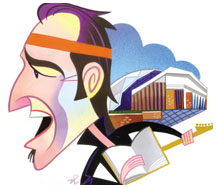
|
|
November 16, 2005: Perspective
Princeton,
Bruce, and me
The Boss on Campus
By Louis P. Masur *85
Louis P. Masur *85 is William R. Kenan Jr. Professor of American Institutions and Values at Trinity College in Hartford, Conn.
Robert de Michiell |
When I arrived at Princeton in September 1979 to begin the doctoral program in history, I proceeded directly to Jadwin Gym. I made the pilgrimage not because of my passion for Tiger basketball, but because of my devotion to Bruce Springsteen.
Springsteen and the E-Street Band had played Jadwin less than a year earlier, in November 1978. That fall, I saw him at the Palladium in New York City and the Capitol Theatre in northern New Jersey, but I missed the Jadwin show. Rumor had it that the band rocked the building so hard it shook the foundation, and I thought I would poke around, looking for cracks.
I took it as a good sign about my studies that my first graduate seminar was co-taught by a visiting lecturer who had been to that concert and appreciated Springsteen. When we weren’t talking about the American Revolution as a patriarchal revolt against authority, we were talking about Bob Dylan, whose “Like a Rolling Stone” in 1965 shaped my teacher’s life, and Springsteen, whose “Born to Run” in 1975 shaped mine.
Over the decades, Springsteen has materialized on campus in many different guises: as performer, subject, student, and soundtrack to our lives. I lived in a dingy apartment on Spruce Street, where I devoured Hoagie Haven subs, prepared for general exams, and played Bruce. When Born in the USA made Springsteen an international megastar in 1984, the title song blared out of windows on campus and the University band performed it at halftime of a football game. At graduate student parties the highlight of the evening was blasting “Dancing in the Dark.” “I’m sick of sitting around here trying to write this book,” Springsteen sings. We’d scream the lyrics and change that last word to “dissertation.”
By that time I was a preceptor in various American history courses. During a review session prior to the final in Stanley Katz’s course The Role of Law in American Society, I scrawled on the blackboard a line from “No Surrender”: “We learned more from a three-minute record than we ever learned in school.” Everyone laughed, and then we tried to figure out the doctrine of adverse possession.
This past summer one of the students from that class, Mike Klein ’87, invited me to a baseball game. Mike is now a lawyer working in New Jersey, and he recently asked about my current project. I explained that I was writing about Springsteen’s Born to Run on the occasion of its 30th anniversary. Mike reminded me how often I had quoted Springsteen in precept and wondered what had taken me so long.
It was a fair question. Of course, in the 1980s rock ’n’ roll history was hardly a respectable field of inquiry in the academy. It never occurred to me to propose a dissertation topic such as youth culture and rock in the 1950s, or Elvis Presley and the black musical tradition. Much has changed. There have been numerous sophisticated books about popular music written both by critics and journalists as well as academics; Princeton’s own Sean Wilentz, a beginning assistant professor of history in 1979, writes often about Bob Dylan and received a Grammy nomination for his essay accompanying Dylan’s Live 1964.
Springsteen scholarship, in particular, has reached mature levels of critical engagement. Numerous books and scholarly articles discuss Springsteen as a cultural icon, analyze his vision of community and the working class, and unpack the religious vocabulary of his songs. There is even a Bruce Springsteen Reader. In September, Monmouth University on the Jersey shore hosted a Springsteen Symposium. Dozens of scholars gathered to scrutinize every imaginable aspect of his career. I delivered a paper on “The Geography of Born to Run” that discusses the album’s sense of place, time, and morality. It turns out that the critical skills I acquired in Dickinson Hall more than 20 years ago applied perfectly well to the task of unpacking Springsteen’s lyrics.
Today it is not unusual to find courses in the departments of American studies, history, English, and music on Springsteen, rock ’n’ roll, and American culture. Next year I plan to offer a seminar on Presley, Dylan, and Springsteen. An insightful critic in his own right, Springsteen once observed that Presley freed our bodies and Dylan freed our minds. Bruce, I think, is working on our souls.
His work exposed and shaped its times: the malaise of the ’70s, the class politics of the ’80s, the spiritual searching of the current decade. He belongs in the college curriculum for the same reason that any figure in American culture belongs: His songwriting addresses central themes in our history. What is the relationship of the individual to the community? How do we improve our lives? What are our obligations to the past and to the future? Five years ago, writer Greil Marcus was teaching an American studies seminar on Prophecy and the American Voice at Princeton and did one better than assign Springsteen: Bruce came to class and participated in a discussion of an Allen Ginsberg poem.
Now, on tour to promote his latest effort, Devils & Dust,
Springsteen will be playing a solo acoustic set in Trenton on Nov. 21
and 22. I have a former student, now a friend, to whom I owe a ticket.
I plan to invite Mike to the concert. I’m sure we’ll learn
some new lessons from a few three-minute songs. And maybe, if we stomp
hard enough, we can leave our mark on the arena floor. ![]()

